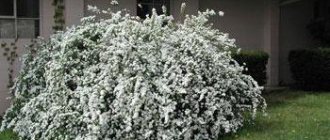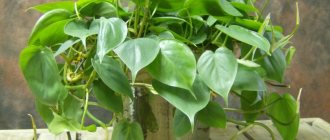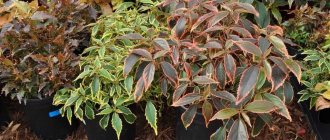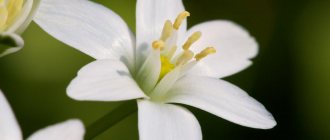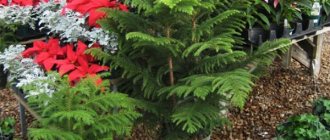The jacaranda plant belongs to the Bignoniaceae family. This genus is represented by shrubs and trees. Such a tall perennial can reach a height of 20 meters and even higher. Its branches are decorated with spectacular double-pinnate leaf plates that are similar in appearance to a fern. That is why this plant is also popularly called the “fern tree”. In nature, jacaranda can be found in Mexico, India and Israel.
The shrub comes from South America, or rather from its tropical zone. It is often grown indoors. The culture is characterized by rapid growth, with its average annual growth being about 25 centimeters. The height of an adult bush can reach up to 200 cm, but only if you do not carry out timely pruning. In indoor conditions, the plant rarely pleases with its flowers, while in nature it blooms in winter or in mid-April.
At the tops of the fragile stems, a large number of bell-shaped flowers of purple color are formed. They are part of large panicle-shaped inflorescences. The plant is also called the “violet tree”, this is due to the color of the inflorescences.
Photo gallery
Only mimosolia jacaranda can be grown indoors. It is better to keep it in rooms with a high ceiling, as it reaches a height of two meters. Jacaranda trees must be pruned before growing. More suitable for greenhouses and “winter gardens” than for a standard room in a Russian apartment.
It is non-toxic, does not affect air purification, and does not emit any harmful substances. Does not belong to the class of poisonous, not harmful to children, adults and pets.
Outwardly, it is often compared to sakura, jasmine and lilac. But in indoor conditions you will hardly find any flowering, so it resembles an ordinary plant with a beautiful stem and graceful leaves.
Main types
Jacaranda mimofolia
The only plant of this species that is capable, albeit with difficulty, of blooming in an ordinary (admittedly well-lit and warm) apartment, even twice a year. The best varieties for growing mimosolia are Delta and Magdalena.
When growing at home, the ceiling height is needed at least 2.7 meters, and preferably more. In the winter months, it is especially important, while maintaining the resting temperature, to also observe the shading regime. It is better to consult specialized literature about its duration and frequency, focusing on varieties and subspecies.
Jacaranda fluffy
A herbaceous perennial, it can have both shrubby and woody forms. This type of jacaranda has pinnate leaves, separated and oppositely arranged, and the inflorescence can take the form of either a panicle at the top or small “bouquets” of leaf axils.
For indoor use, office premises with a ceiling height of more than 3 meters are preferable. This does not mean that the plant will outgrow this mark, but it is extremely sensitive to air volume.
It requires special knowledge, so the employee assigned to care for the fluffy jacaranda must have it.
How does it bloom?
In wild conditions, jacaranda grows up to 15 meters, it has a lush crown and wide feathery leaves that have elongated bright green plates. The tree has large inflorescences with five dozen purple or bluish flowers with jagged calyxes and curved bell-shaped corollas, which are slightly lowered and bent.
Mimofolia jacaranda has violet-bluish inflorescences with small calyxes. The plant with flowers can be seen more often in October and early November. In indoor conditions, it blooms twice a year: in spring and autumn. Varieties of this species, Magdalena and Delta, are also used for cultivation.
Description of the plant
Jacaránda is a tree plant from the Bigoniaceae family, growing in South America (Brazil, Mexico, Bolivia), Africa (Zimbabwe) and Australia in tropical and subtropical lowland and mountainous regions. The name "jacaranda" is translated from Portuguese as "having hard wood." Locals call these plants Black Pui, fern tree, for the shape of the leaves, rosewood, violet tree or rosewood tree.
The trees can reach 20-30 meters in height, but there are also shrubs among them, no higher than 2 meters. They are a semi-deciduous species; if the ambient temperature drops to 0°C, the leaves may fall off. Young plants die at -3°C, and adults rarely withstand temperatures below -7°C.
Their leaves are fern-like, feathery, bright green. The bark can have different shades: from red to chocolate and even purple. The shape of the flower resembles a bell, about 5 cm long. They are collected in brushes containing 30-50 flowers. Petals can have a variety of shades from white to blue, indigo, and violet. The tree blooms very profusely in October-November; under the weight of the flowers, the branches bend down to the ground. The sticky sweet nectar and scent that lingers in the air attract insects that pollinate the flowers. The duration of the flowering period is 1.5-2 weeks. After wilting, seed pods form in place of the showy flowers. Ripe capsules burst and the winged seeds scatter over long distances.
Having a very decorative appearance, jacaranda is used for landscaping streets, parks, and public gardens in cities in Africa, Australia, and South America. But it’s not just the appearance of trees that is valued. They have very hard, durable wood; valuable qualities are in demand in the manufacture of furniture, musical instruments, various souvenirs, interior items, and so on. During processing, the core of the tree acquires a beautiful color - red-brown with a purple tint.
Signs and superstitions
It is believed that jacaranda has a strong magical effect, so keeping it at home is extremely beneficial for the family. This is a tree that gives beauty and brings good luck. It has a number of properties that cleanse the aura and fill the space with positive energy.
It brings prosperity and prosperity. The violet tree purifies negative thoughts and instills harmony and tranquility in the soul. However, for some people it causes apathy and drowsiness.
According to Feng Shui, it is better to place jacaranda in wide spaces near windows. It is not advisable to place it next to the bed and resting place, in the kitchen or in the office.
Signs associated with the flowering of the violet tree are also common. This process promises well-being, brings prosperity to the house and may indicate an imminent addition to the family.
When purchasing a plant, pay attention to your interior. Jacaranda cannot be in a cramped and narrow space; it needs space. Don’t forget to move it into the shade in hot weather, otherwise the leaves may soon turn yellow.
When purchasing, pay attention to the leaves - if they are yellowish at the edges, and the leaves themselves are slightly curved, then this plant may soon wither.
Choose a violet tree with bright green leaves that have a glossy sheen.
Varietal diversity
For indoor decoration, two types of plants are used - the mimosifolia jacaranda tree and the fluffy jacaranda tree (Jacaranda tomentosa) . The second type is just beginning to gain popularity, so it can be found quite rarely in stores.
Downy jacaranda (Jacaranda tomentosa)
The type of mimosolous beauty is represented by a large number of varieties, among which the most popular are:
- Jacaranda delta. Decorative, deciduous tree, reaching two meters in height. The foliage is lush and light green.
Jacaranda mimofolia Delta
Jacaranda delta is the most popular for landscaping at home, but, unfortunately, it blooms extremely rarely. - Magdalena . Characterized by fast, intense growth. An adult specimen can reach three meters in height. The foliage is light green and fluffy. It blooms extremely rarely in pots; it blooms only in open ground. Used as landscaping for spacious rooms.
- Bansai Blue . Reaches only 75 centimeters in height, specially bred to form a small tree in the bonsai style.
Is Jacaranda suitable for bonsai?
The plant is used for cultivation using Japanese bonsai technology. This allows you to control the growth of the crown and leaves, as well as create your own miniature garden. There is even a separate variety of jacaranda, “Bonsai Blue,” which does not reach a length of more than 75 centimeters. For cultivation, the following conditions must be met:
- in the first year you cannot prune it;
- in the second year, cut to 10 cm and wait for side shoots to appear;
- then pinch the jacaranda, trimming the leaves and crown;
- to form the crown, you can use soft wire, which must be removed after 3 months;
- It is better to cut off all large leaves;
- Jacaranda will branch worse when standing in the shade.
Types and uses of jacaranda
The wood of the plant belongs to the heartwood species - rosewood, or rosewood. Its mass has a beautiful bright brown color with purple veins, the structure is very dense. Thanks to the saturation with essential oil, the surface of the wood shines on cuts and emits a subtle aroma. This is an expensive material used for the manufacture of one-piece collectible furniture, handmade parquet, musical instruments, figurines and souvenirs.
The most common types of jacaranda:
- mimofolia - a straight-trunked tree of medium height with a beautiful carved crown formed by long lateral branches with double pinnate leaves up to 40–50 cm in size. It blooms profusely, the petals are bright lilac or blue, the species is common in the southern provinces of Argentina and Brazil;
- fluffy (jasmine): the height of the trees is about 10–15 m, the shoots are heavily pubescent, the leaves are pinnate, consist of 4 pairs of transversely arranged ovoid leaves, the flowers are golden or purple in color;
- small-flowered: found in Argentina, prefers areas at an altitude of more than 500 m above the ocean, flowers are smaller than those of other species, blue and light blue, collected in wide paniculate racemes;
- pointed: deciduous appearance, trunks with multiple branches, pinnate leaves, each leaf lobe has a characteristic pointed tip, inflorescences - like mimosolia jaccaranda: panicles of tubular cups of rich blue and lilac hue;
- fern-leaved: includes evergreen and deciduous varieties, found throughout South America, trunks of medium height - up to 12 m, leaves are bright green, double pinnate, clusters of inflorescences - from 7-10 cups of all shades of blue.
There are also several selective tree species bred for gardening and landscape design.
Home care
In summer it is unpretentious and easily adapts to the absence of sun, and in the heat it practically does not dry out. It is recommended to keep it at a temperature of - 13 °C. In winter, it needs a cool room, with a temperature of about 7 °C. Sudden changes in temperature are not allowed, as the plant is in “hibernation”.
High humidity of at least 60% is desirable; daily spraying with soft water at room temperature is required. In winter, you need to water less often, up to once every 3-4 weeks.
The violet tree loves light, so it can be placed in a window all day. Young plants can exist in light partial shade. In winter, additional light sources are needed.
The magical properties of jacaranda
In the tribes on whose lands the violet tree grows, there are many legends, myths, and superstitions associated with it. In Australia, for example, he is associated with the daughter of the Moon, who flew to Earth on the bird Mitu. The beautiful girl brought people knowledge and wisdom, which she generously shared with them, sitting at the foot of a wonderful tree. Now in Sydney and other large Australian cities, jacaranda grows near almost every university. And students believe that if, while going to an exam, they catch a flying violet flower, or if it falls right on their head, then success during the exam is guaranteed.
Some African tribes believe that the Blue Spirit lives in the crown of the tree. It helps to make the right decision in complex, difficult or conflict situations. Among other peoples, rosewood serves as a kind of amulet for babies. According to tradition, when a baby is born, parents plant a new tree in his honor.
Transfer
To prepare a jacaranda for transplanting you need:
- treat the leaves with a protective spray and trim them;
- prepare a new pot and soil;
- add fresh humus to the soil;
- treat the soil with phosphates.
A transplant may be needed:
- after the purchase;
- because the flower has grown and the pot is cramped;
- due to improper soil;
- due to flower diseases.
Replanting during flowering is undesirable, but is possible only if the plant has been attacked by pests and are beginning to approach the root system.
Taxonomy
The taxonomic status of the blue jacaranda is uncertain. THIS is about the older name, J. acutifolia
, as a synonym for
J. mimosifolia
.
However, some modern taxonomists maintain a distinction between the two species, considering them geographically distinct: J. acutifolia
is endemic to Peru, while
J. mimosifolia
is native to Bolivia and Argentina.
If such a distinction is made, the cultivated forms should be considered J. mimosifolia
, as they are thought to originate from the Argentine stock.
Other synonyms for blue jacaranda are J. chelonia
and
J. ovalifolia
.
The Blue Jacaranda belongs to the Monolobo
the Jacaranda
genus .
Growing and Reproduction
Jacaranda is grown in 2 ways:
- seeds;
- cuttings.
What needs to be done for good seed germination?
- Growing from seed requires good soil.
- It is necessary to choose suitable soil with proper drainage.
- Use small ceramic pots.
- The temperature during germination should be up to 30 °C.
- You need to stretch small cotton wicks through the drainage and lower them into a container of water.
- The top of the drainage should be covered with soil and a seed should be placed in the center.
- The seed must be sprinkled with a small amount of soil.
- The pot should be placed in a transparent plastic container with a lid or grown in a greenhouse.
- It needs to be exposed to the light.
It is necessary to spray as the soil dries using a spray bottle. Shoots appear after 2-4 weeks.
Propagation by cuttings
- Cut the stalk.
- Dry it for several days in a pantry or other dry, dark place.
- Place in a heteroauxin solution for a day to accelerate root formation.
- Add moist substrate to the planting site.
- Plant the cuttings at an angle of 45 °C, adding peat and fine sand to the mixture.
- Cover with film and keep at 25°C.
Growing a delicious “guest from the tropics”
The plant is unpretentious in planting and care; it only requires creating conditions close to the natural environment. The tropical climate is characterized by high humidity and warmth. For this reason, the apartment should be more than +25...+27˚С in summer, and +17...+18˚С in winter. In November-December, indoor jacaranda enters a dormant state. Therefore, sudden changes in temperature are contraindicated for her. Proper development during this period is achieved thanks to optimal lighting.
The exotic culture is adapted to unexpected temperature drops (up to +13˚С), but only for a short time. In this case, the mimofolia variety can shed its foliage.
Special attention is paid to lighting. Experts recommend that the fern tree receive up to 3-4 hours of bright sunlight every day, especially in winter. For the rest of the day, it is recommended to shade the openwork crown of the flowerpot. The ideal location for placing a flower is windows facing east or southeast.
The crown develops as symmetrically as possible if the pot is regularly rotated around its axis. This way the shoots can receive the same amount of sunlight.
Indoor jacaranda needs a humid climate
In summer, watering is carried out every 2-3 days so that the soil is constantly moist, but not swampy. In winter, the number of procedures is reduced to 2-3 per month. During the dormant period, the soil is moistened carefully and moderately. As soon as the top layer dries to a depth of 2 cm, the soil is sprayed with a spray bottle. This air-drip irrigation simulates tropical rains. For the event, only warm and well-settled water is used.
It is also recommended to mulch the surrounding area with:
- crushed sphagnum;
- coconut substrate;
- ate bark.
This natural cover allows moisture to linger in the ground for a long time, thereby creating the proper microclimate for the plant. In addition, the air humidity in the room is maintained within 65-70%, and in winter - not lower than 30%. To obtain such indicators, the violet tree is regularly sprayed. The procedure is performed daily in the evening. The spray bottle contains water at room temperature, which has been left to sit for 24 hours.
Additional tricks for creating a tropical microclimate are trays with wet pebbles. In other cases, conventional water containers/reservoirs are widely used.
The importance of pruning and fertilizing
When spring comes, young and overly elongated shoots are pinched. Dried or deformed leaves are also removed. This pruning technology activates the growth of lateral branches. As a result, the fern tree acquires a spherical crown. To obtain a Japanese-style bonsai specimen, up to 10 cm of the main trunk is removed annually. The lateral branches are formed using soft wire, which secures the crown for 3 months.
Like all other indoor plants, Jacaranda mimofolia needs regular feeding.:
- mineral complexes;
- potash fertilizers;
- rotted organic matter mixed with peat under the roots.
Watering and fertilizing are always combined. During wintering, as well as when shedding leaves, the crop does not need nutrients, so no preparations are applied.
The rate of use of the given compositions is selected in accordance with the instructions. During active vegetative growth, fertilizing is applied every 2-4 weeks. The tropical plant responds especially well to organic fertilizers. Regardless of care and maintenance conditions, indoor jacaranda can shed its leaves in February or early March.
Subtleties of planting and transplanting
When the root system actively strives to “leave” the pot, the flowerpot is transplanted into a container of larger diameter (with a difference of 3 cm). For adult specimens, the event is planned every 3-4 years. A prerequisite is the presence of a hole at the bottom of the pot and a good drainage layer (broken brick in the lower part and sand in the upper part).
The soil composition is prepared from 4 main components (in a ratio of 2:1:1:1):
- turf land;
- humus;
- peat (slightly acidic);
- sand (coarse grain) or perlite.
A pot for a tropical plant is made of clay or ceramics. Unlike plastic, natural materials are able to retain moisture and “breathe”.
In some cases, deciduous soil (4 parts) is added to obtain the most loose, airy substrate. The transplantation process is carried out very carefully. When the rhizome is buried, the growing point is not buried. Otherwise, the growth and development of the violet tree will stop.
Propagation by seeds or cuttings
Jacaranda from seeds can be grown without much effort. Planting material is germinated before sowing. The grains are wrapped in damp gauze, which is periodically sprayed, for only 2-3 days. After this, the seeds are planted in the soil mixture to a depth of 1 cm. The soil is watered abundantly with water, and the container is covered with film/glass. The container is sent to a room with a temperature of +22…+24˚С.
The mini-greenhouse is ventilated and moistened daily. When seedlings appear (on 21 days), the shelter is removed. In the phase of 2-3 true leaves, seedlings are planted in separate pots.
Indoor jacaranda is propagated by cuttings in the following sequence:
- in May-July cuttings are prepared (up to 10 cm long);
- treated with a growth stimulator;
- planted in a moist soil mixture under a film;
- after 14 days, the seedlings are transferred to new pots.
In floriculture, the method of rooting cuttings in water with the addition of crushed coal is also widely used. Before this, the stems are sprayed with root. As soon as the roots grow to 1.5 cm, the shoots are planted in the soil.
If the foliage of a fern tree begins to turn yellow, it means that the tropical crop lacks iron.
Most often, indoor jacaranda suffers from rotting of the root system. This is due to poor drainage or excess moisture. Then the damaged roots are removed, the flower is transplanted into another container in compliance with all planting rules, and an irrigation system is established. By carefully observing their “ward”, many even achieved the flowering of an exotic tree.
Fertilizer and feeding
The best “nutrients” are fertilizers based on phosphorus and superphosphate. It is also recommended to use lime, but it should not be combined with acidified soil and alkaline fertilizers. It is better to use fertilizers in dry form, but you can add a little con class=”aligncenter” width=”1200″ height=”1200″[/img]
Organic
Manure, bird droppings, peat, silt, sawdust and tree bark, green manure, composts.
Mineral
They are considered excellent assistants when processing plants, strengthen them and provoke rapid growth.
- Potassium.
- Phosphorus.
- Complex mineral fertilizers.
You can buy mixtures of peat and sand, compost, as well as various mineral fertilizers. Among them: “Superphosphate”, “Ammophos”, “Urea” and others.
Kornevin is a cream-colored powder, a small amount is used in dry form, suitable for dipping the end of the cutting when transplanting for better rooting or rapid development of roots.
Heteroauxin is the main phytohormone of plants, promoting active metabolism and preventing rapid leaf fall.
You can prepare fertilizers at home by mixing natural ingredients with mineral ones.
It is necessary to feed during growth once every 2 weeks. It is very useful for jacaranda to use organic fertilizers, alternating them with mineral ones even during the dormant period. Watering
Water the jacaranda sparingly, as it does not like excessive moisture. It needs abundant watering during the period of active growth - from spring to autumn. The water should be at room temperature and soft; do not water it with cold water, as the violet tree may “get sick.” In winter, you need to water less often, and in especially cold months, up to once every 3-4 weeks.
Accommodation
Jacaranda prefers bright light; it tolerates direct sunlight for about 3 hours. The plant feels comfortable near western and eastern windows. The pot must be rotated periodically, since one-sided lighting can deform the crown.
The temperature required for normal plant development in summer is +25 °C, in winter – +19 °C. In summer, jacaranda loves to “walk” in the air. In this case, the place where you place the flower should be protected from the wind.
Diseases
Leaves curl and turn yellow
Possible reasons are dry air and soil, cold, drafts. It is recommended to inspect your jacaranda for pests. If insects are not found, you need to adjust the care and maintenance regime.
Leaf chlorosis
Develops due to high lime content in the soil, poor watering, deficiency of iron, magnesium, sulfur and zinc. Accompanied by yellowing of leaves and slow growth. They are transplanted into nutritious soil and fertilized with fertilizers with a high content of missing microelements.
Root rotting
Lack of drainage, dense soil, excessive watering. Check the condition of drainage and soil. If necessary, replant the plant, stop watering, then water moderately.
Popular culture links
Pretoria, the administrative capital of South Africa, is popularly and poetically known as Jacaranda City or Jacarandastad in Afrikaans due to the large number of trees that turn the city blue in spring. The name Jakarandastad is often used in Afrikaans songs, such as in Staan Op
to Kurt Darren. Far from their native Brazil, jacaranda trees bloom every October. Water shortages South Africa is trying to eradicate alien plant and tree species, including the jacaranda. Recognizing the tree's popularity among local residents, the government announced that it would not remove the trees, but banned the planting of new jacarandas.[12]
The Australian Christmas song "Christmas Where the Bubble Gum Trees Grow" makes reference to jacaranda trees, as their blossoms can only be seen in the summer - as the song explains: "When the jacaranda tree comes into bloom, Christmas time approaches."[13] The University of Queensland at Brisbane is particularly well known for its ornamental jacharandas, and a common saying among students is that their bloom signals time for serious study before end-of-year exams.[14]
In Argentina, writer Alejandro Dolina, in his book Crónicas del Ángel Gris
(
Chronicles of the Gray Angel
), tells the legend of a massive
Jacarandá
tree planted in Plaza Flores in Buenos Aires, which was able to whistle tango songs on demand.
Maria Elena Walsh dedicated her song Canción del Jacarandá
to the tree.
Miguel Brasco's folk song Santafezino de Veras
mentions the scent
of Jacarandá
as a distinctive feature of the coastal Province of Santa Fe (along with willows growing near the rivers).
Folklore
The jacaranda at the University of Sydney is a quadrangle;
its flowering was usually associated with exam times.[15] The tree collapsed in October 2016.[16] Purple Scare
is a term used by students in south-east Queensland for student stress during the late spring and early summer. "Purple" refers to the colors of the Jacaranda trees that bloomed at the time and were widely planted throughout the county. “Panic” refers to the pressure to complete assignments and study for final exams.[17] This is especially noticeable for students at the University of Queensland's St Lucia campus in Brisbane, where jacarandas are found in abundance. The best jacaranda trees in Brisbane - picnic under the purple flowering trees!
Jacaranda in bloom is also known as the exam tree
.[17]
Conversely, while the jacaranda flowering time of year in Pretoria coincides with the end of year exams at the University of Pretoria, legend has it that if a jacaranda flower falls on a student's head, the student will pass all exams.[18][19]

